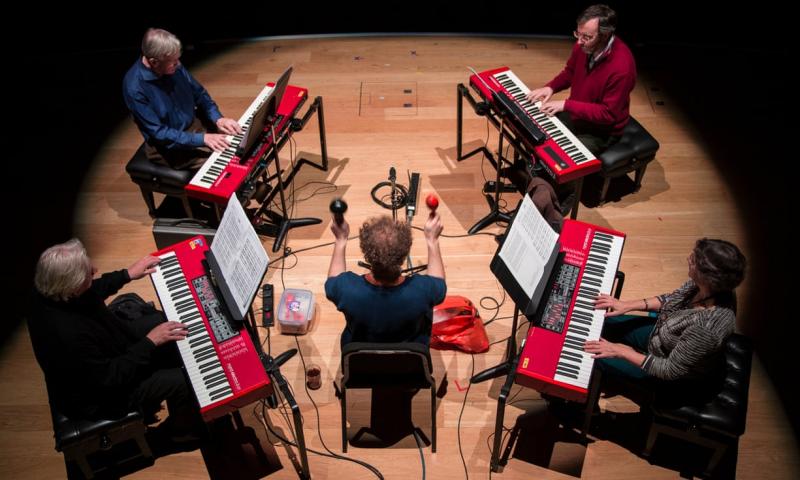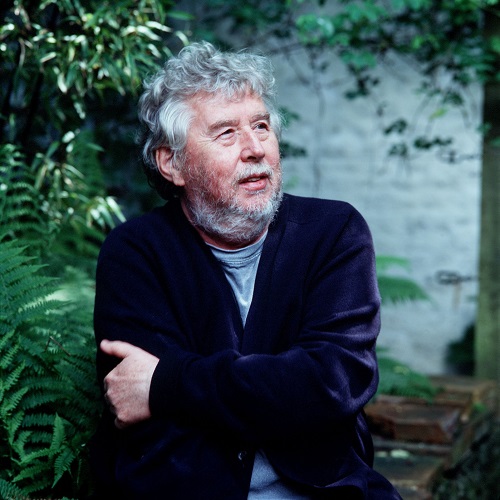Lawson, London Sinfonietta, Kings Place Review – diverse explorations of time | reviews, news & interviews
Lawson, London Sinfonietta, Kings Place Review – diverse explorations of time
Lawson, London Sinfonietta, Kings Place Review – diverse explorations of time
A surprise late addition from Birtwistle is the highlight of wide-ranging programme

Kings Place takes a broad and "curated" approach to season programming, and events often have to fit into very nebulous and abstract themes. This concert by the London Sinfonietta was part of a strand called "Time Unwrapped" and sought to explore the role of time in music.
The evening began with a pianola demonstration from Rex Lawson, the instrument’s acknowledged contemporary master. Lawson performs ("pedals", as he puts it) on an upright mahogany-encased unit that fits onto the front of a standard piano, in this case the Kings Place Steinway. His introductions were affable and entertaining, but without going into too much detail about the workings of his device – so much the better, the mystery is part of the appeal. He was more articulate on the role of rubato in pianola performance, performing rolls of Rachmaninov and Chopin, in which the pianolist is required to consciously disrupt the metrical flow, and also an interesting one from Percy Grainger, Shepherd’s Hey, where the composer had indicated the tempo changes himself on the roll. But the highlight was a series of Nancarrow Studies, music that Lawson acknowledged was written for fully mechanical performance, but then went on to demonstrate the value of having a human foot on the accelerator pedal in some truly exhilarating readings.
As the clock struck eight, we moved on to a segment of American Minimalism. Morton Feldman’s Bass Clarinet and Percussion is a typical late work, with quiet repeating modules in the clarinet accompanied by two percussionists, playing inscrutable, quiet clusters in rhythmic unison. Feldman often makes huge technical demands on his players to only middling musical effect for his listeners, but the efforts of these three performers mostly paid off. Clarinettist Robert Plane sometimes struggled to maintain the evenness of his tone, especially in the continuous high, quiet music, yet the endlessly still mood persisted, and to eerie effect. This was followed by Steve Reich’s early work Four Organs. This is Reich at his most confrontational, presenting simple rhythmic patterns in gradual evolution, without any apparent concern for the musical implications of their resulting dissociation. But the squelchy, analogue synthesisers provided appealing period sound. Kudos, too, to percussionist Louise Goodwin, who had the unenviable task of playing a continuous quaver pace on maracas throughout the whole work.
 The third segment opened with Birtwistle’s Pulse Sampler (1981), but the composer had substantially rewritten the work, even since the programme went to press. The note described the piece as for oboe and claves, but the stage was set up with a substantial percussion section instead. Birtwistle (pictured left by Hanya Chlala) introduced the performance, and it was clear that he had been inspired by the theme of this concert to revisit the piece. He also mentioned a recent visit to the exhibition of Anni Albers’ work at Tate Modern. She was a member of the Bauhaus group who specialised in weaving. The connection for Birtwistle was the parallel between the fixed lateral dimension of weaving and the role of pulse in music.
The third segment opened with Birtwistle’s Pulse Sampler (1981), but the composer had substantially rewritten the work, even since the programme went to press. The note described the piece as for oboe and claves, but the stage was set up with a substantial percussion section instead. Birtwistle (pictured left by Hanya Chlala) introduced the performance, and it was clear that he had been inspired by the theme of this concert to revisit the piece. He also mentioned a recent visit to the exhibition of Anni Albers’ work at Tate Modern. She was a member of the Bauhaus group who specialised in weaving. The connection for Birtwistle was the parallel between the fixed lateral dimension of weaving and the role of pulse in music.
To this end, he recreated Pulse Sampler, originally for solo oboe with percussion accompaniment, into a full duet between the two players. The new percussion part is still dominated by woody sounds, a range of wood blocks and temple blocks, but also expands into cymbals and untuned metallic percussion, as well as a cajón (a first for Birtwistle?) on which the percussionist sits. An excellent performance here from both players, but especially oboist Melinda Maxwell, always lyrical and clear, despite Birtwistle’s often tortuous lines. And to conclude, Stockhausen’s Zeitmasse, an early work for wind quintet (cor anglais replacing horn). Birtwistle implied that Stockhausen got the heart of the programme’s time theme better than any of the preceding composers. Unusually, he did so without any overt theorising or applied philosophy, and the Sinfonietta did his score full justice, a core-repertoire piece, if ever there was one for this ensemble.
rating
Explore topics
Share this article
The future of Arts Journalism
You can stop theartsdesk.com closing!
We urgently need financing to survive. Our fundraising drive has thus far raised £49,000 but we need to reach £100,000 or we will be forced to close. Please contribute here: https://gofund.me/c3f6033d
And if you can forward this information to anyone who might assist, we’d be grateful.

Subscribe to theartsdesk.com
Thank you for continuing to read our work on theartsdesk.com. For unlimited access to every article in its entirety, including our archive of more than 15,000 pieces, we're asking for £5 per month or £40 per year. We feel it's a very good deal, and hope you do too.
To take a subscription now simply click here.
And if you're looking for that extra gift for a friend or family member, why not treat them to a theartsdesk.com gift subscription?
more Classical music
 Kanneh-Mason, Britten Sinfonia, Shave, Milton Court - a grin and a big beaming smile
A pair of striking contemporary pieces alongside two old favourites
Kanneh-Mason, Britten Sinfonia, Shave, Milton Court - a grin and a big beaming smile
A pair of striking contemporary pieces alongside two old favourites
 theartsdesk at the New Ross Piano Festival - Finghin Collins’ musical rainbow
From revelatory Bach played with astounding maturity by a 22 year old to four-hand jazz
theartsdesk at the New Ross Piano Festival - Finghin Collins’ musical rainbow
From revelatory Bach played with astounding maturity by a 22 year old to four-hand jazz
 First Person: Manchester Camerata's Head of Artistic Planning Clara Marshall Cawley on questioning the status quo
Five days of free events with all sorts of audiences around Manchester starts tomorrow
First Person: Manchester Camerata's Head of Artistic Planning Clara Marshall Cawley on questioning the status quo
Five days of free events with all sorts of audiences around Manchester starts tomorrow
 Goldscheider, Brother Tree Sound, Kings Place review - music of hope from a young composer
Unusual combination of horn, strings and electronics makes for some intriguing listening
Goldscheider, Brother Tree Sound, Kings Place review - music of hope from a young composer
Unusual combination of horn, strings and electronics makes for some intriguing listening
 theartsdesk Q&A: composer Donghoon Shin on his new concerto for pianist Seong-Jin Cho
Classical music makes its debut at London's K-Music Festival
theartsdesk Q&A: composer Donghoon Shin on his new concerto for pianist Seong-Jin Cho
Classical music makes its debut at London's K-Music Festival
 Helleur-Simcock, Hallé, Wong, Bridgewater Hall, Manchester review - moving lyricism in Elgar’s concerto
Season opener brings lyrical beauty, crisp confidence and a proper Romantic wallow
Helleur-Simcock, Hallé, Wong, Bridgewater Hall, Manchester review - moving lyricism in Elgar’s concerto
Season opener brings lyrical beauty, crisp confidence and a proper Romantic wallow
 Kohout, Spence, Braun, Manchester Camerata, Huth, RNCM, Manchester review - joy, insight, imagination and unanimity
Celebration of the past with stars of the future at the Royal Northern College
Kohout, Spence, Braun, Manchester Camerata, Huth, RNCM, Manchester review - joy, insight, imagination and unanimity
Celebration of the past with stars of the future at the Royal Northern College
 Jansen, LSO, Pappano, Barbican review - profound and bracing emotional workouts
Great soloist, conductor and orchestra take Britten and Shostakovich to the edge
Jansen, LSO, Pappano, Barbican review - profound and bracing emotional workouts
Great soloist, conductor and orchestra take Britten and Shostakovich to the edge
 Jakub Hrůša and Friends in Concert, Royal Opera review - fleshcreep in two uneven halves
Bartók kept short, and a sprawling Dvořák choral ballad done as well as it could be
Jakub Hrůša and Friends in Concert, Royal Opera review - fleshcreep in two uneven halves
Bartók kept short, and a sprawling Dvořák choral ballad done as well as it could be
 Hadelich, BBC Philharmonic, Storgårds, Bridgewater Hall, Manchester review - youth, fate and pain
Prokofiev in the hands of a fine violinist has surely never sounded better
Hadelich, BBC Philharmonic, Storgårds, Bridgewater Hall, Manchester review - youth, fate and pain
Prokofiev in the hands of a fine violinist has surely never sounded better
 Monteverdi Choir, ORR, Heras-Casado, St Martin-in-the-Fields review - flames of joy and sorrow
First-rate soloists, choir and orchestra unite in a blazing Mozart Requiem
Monteverdi Choir, ORR, Heras-Casado, St Martin-in-the-Fields review - flames of joy and sorrow
First-rate soloists, choir and orchestra unite in a blazing Mozart Requiem
